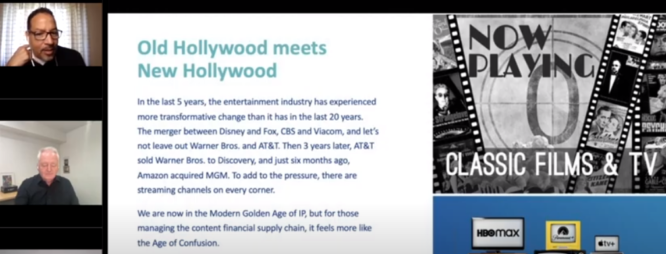
InvenioLSI, SAP Tout Solution to Tighter Control on Production Spend, Budgets
InvenioLSI Content Financials provides a solution for media and entertainment (M&E) companies looking to achieve stringer control of their production spending, InvenioLSI and SAP executives said Nov. 10 during the webinar “Content Financials: Your Solution to Tighter Control on Production Spend, Budgets, Accounting, and Finances.”
Those who viewed the webinar learned how to manage the financial nuances of content production within the changing industry; cost control and process integration; how InvenioLSI Content Financials fit into the Digital Core S/4HANA; and how to take advantage of Content Financials in a pre-existing SAP suite.
A demonstration of the Content Financials dashboard was also provided, showing how it can be used from greenlight to budget approval to amortization.
The webinar was presented jointly by the two companies, Caroline Silva, VP of global marketing at InvenioLSI, pointed out. “We’re actually a gold partner with SAP and we’ve worked with SAP for over 24 years,” she added.
Shyam Jajodia, VP of PreSales & Solution Architecture at InvenioLSI, noted he’s been working in multiple industries with SAP for the last 24 years and “we’re looking forward to bringing the power of SAP to all those folks who are looking for a new solution and also helping those folks who are already using SAP get more out of their solution.” That is “kind of the main reason for this webinar,” he added.
 SAP was represented on the webinar by Richard Whittington, its GM of M&E. “We as SAP power most of the major media companies in the world,” he noted.
SAP was represented on the webinar by Richard Whittington, its GM of M&E. “We as SAP power most of the major media companies in the world,” he noted.
James Maysonet, VP of media and entertainment at InvenioLSI, then pointed to some of the challenges facing the M&E sector today. “Twenty-three years ago, when I started in this industry, I was with MGM and the top-selling titles were on VHS”: the movies Roadhouse and Overboard, he said.
“Back then, if a release had done poorly at theatrical, it was able to make up for the box office losses when it was released on video,” he pointed out. “Well, those days don’t exist anymore. So it’s all about streaming [and] it’s all about subscribers and that requires quality and quantity,” he said.
There is “massive” demand for streamed video content today, he said, noting there are “roughly about 14,000 streaming companies at the global level” thatmake content available on demand or for live streaming.
“That level of demand is what we’re here to talk about,” he said, adding: “It is being felt by those that are approving content…. So the pressure’s on them to get more throughput to the hopper and which ones are right and which ones are within cost control that could be managed and leveraged to meet the demand,” he said.
You know, how to keep them, uh, um, you know, invested into that streaming organization and the brand, the, the concept. You know, it’s, it’s becoming more and more, um, difficult cause of this level of demand and pressure, um, way upstream.
“The other challenges that are being faced as well [are] the part of the old Hollywood meeting in Hollywood,” he added. “For organizations like the Netflix teams and Amazon’s that are very, very tech heavy [and] driven by technology and now are being infused more and more with people that come from production lines, come from the traditional studio style of business … it’s an interesting contrast and how to merge those two cultures.”
Other Challenges
Pointing to other challenges, Jajodia said: “The distribution models are changing” and that is putting a “tremendous pressure on revenues.”
“The cost of content continues to go up,” he noted, explaining: “So that’s our challenge here. And in order to do that, we need technology that can help us manage the cost of content financials. And that’s exactly what InvenioLSI’s Content Financials does.”
What the solution does is it “integrates and facilitates the entire content, financials, value chain within SAP” and, “starting from the content approval process, there is an actual content approval form that can then be routed to different people” and procurement controls, he said.
He added: “You can use SAP payables to make payments…. You can track your content inventory, you can capitalize [on] the content and then amortize it over time, do allocations, all these things.”
And “why is this important?” he asked. “What we are seeing is a lot of our customers, they’re using SAP as their financial system, but they’re focused pretty much on operational” financial issues: your consolidation and group reporting or company level reporting, accounts payable and receivables, how you make payments, receive payments, etc.”
A demonstration was also provided to viewers.
